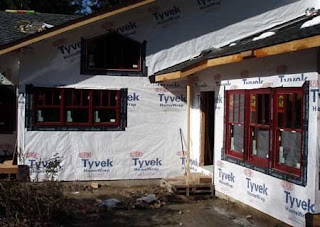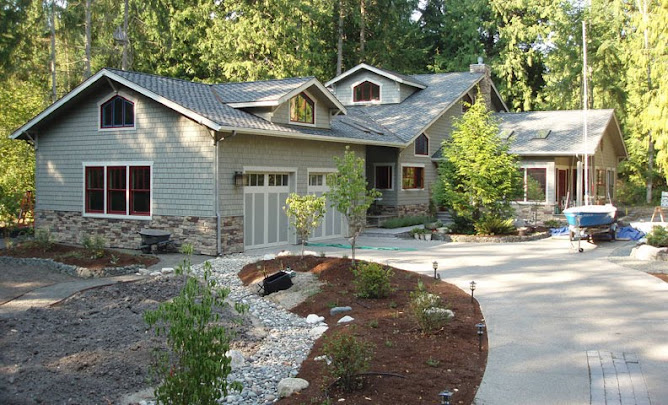Once the committee made a decision to accept our roofing choice, we needed to select a roofing company. You'd think that this is straightforward, but not always. In Denver the least expensive roofing estimate we got for the old house was about $7500, and the most expensive (of 5 bid) was about $13,500. All the same materials and specs, so it pays to shop around. We ended up using the $7500 guy because he was the only one the crawled all over the roof and was willing to discuss the job in detail. Other than being a bit slow and singing show tunes on the rooftop, we were entirely satisfied with Peter Douglas (Covenant Roofing). Now that house had 2500 sq ft of roofing on a 12:12 pitch and one dormer. It was a complete tear off and redeck, and used 30 yr shingles (not the best, but pretty good for the purpose of resale).
On the new house we have about 4200 sq. ft of roofing at a 5:12 pitch (much easier to climb on). The underlayment (#30 tar paper) is already done ($1500), so the bids we got were for the Pabco Paramont Advantage (TL, 50 yr, 495#/sq.), with is comparable with the GAF Grand Canyon and CertainTeed Presidential TL shingles. The bids included all valley flashing (24" metal), sidewall flashing, and installation of the roof jacks (vents), exhaust vents, and skylights (9).

Our preferred roofer came in high, as he predicted so this presented a bit of a dilemma because we really liked the guy (Eric). He'd said that he had never got a roofing job in Kala Point because he was too expensive (compounded with the shingle cost). Eric bid about $17,800 for the job.
The second most expensive bid came from another likable guy, Joe Bartlett of Port Ludlow, a tony little village down the water. Boats, seaplanes and retired executives come to mind. Bartlett bid $15,124 and might have come down $100 because he overestimated the number of skylights by one. No matter, he was outbid by two others.
The second least expensive bid came from some guys in Port Orchard, down near Bremerton. C&M Construction (Cloise and Mike). They prepared a very complete estimate and had good refs (voted N. 1 contractor in S. Kitsap for 2008; but who voted?). Anyway they came in at $13,517, a pretty good price.
The least expensive bid was from the local, big-dog roofing company, Hope Roofing. I had figured they'd be high (big building, lots of employees, etc.), but they weren't. I wanted to use a local company to keep our bucks in the area. At first the bid of $13,192 was the low one, but then I noticed (yes, read the fine print) that they wanted an additional $125 for flashing of each skylight and chimney. At 9+1, that amounted to $1250 (+tax = a total of $1355) which pushed the real estimate up to $14,547. I found the additional amount unwarranted, since we purposely selected Velux QFS skylights, which are self-flashing and very easy to roof on top of. So, Steve Ford waived the skylight flashing cost and we settled for the original low bid of $13,192.
Assuming that they install 42 squares of roofing, the cost will be $314 per square. Add on the $36 per square cost for the underlayment, and we netted out at $350 per square. Sounds like a hell of a lot of money to keep rain off your heads, but the Denver house came out at $300 per square with the tear off and a much lesser grade shingle (ca. half the cost).
So if you're looking to roof or reroof in the near future, these numbers should help. Roofers are a bit hungry right now (they all came right out and got bids to me in a few days), and shingle prices are steady, not increasing like last summer (remember that asphalt is the dregs in the petroleum distillate chain and oil was @ $140 bbl). I suspect that we could roof a new house outside of Kala Point for about $250/square with a good double-layer shingle (GAF Sequoia or Presidental, or Pabco Paramont). We'll call that additional $100 a square (or $4200) one of the costs of living in a lovely, but covenant-controlled community. We could have opted for wooden shingles or cement tiles at $25,000+, or slate at $75,000-$100,000, but then we wouldn't be having any kitchen appliances and Nancy would be a widow.

















